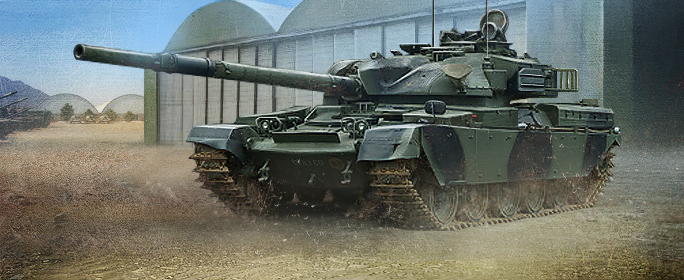
Type 97 "Shinhoto Chi-Ha" Restoration
By: Mike "Moonshadow" Maloney
(3rd ArmyGroup)
One of the most produced and little understood of the Imperial Japanese armor that saw action in World War II was the Type 97 "Chi-Ha" and its upgraded sister, the "Shinhoto Chi-Ha." This article is about the strengths and weakness of the "Shinhoto."
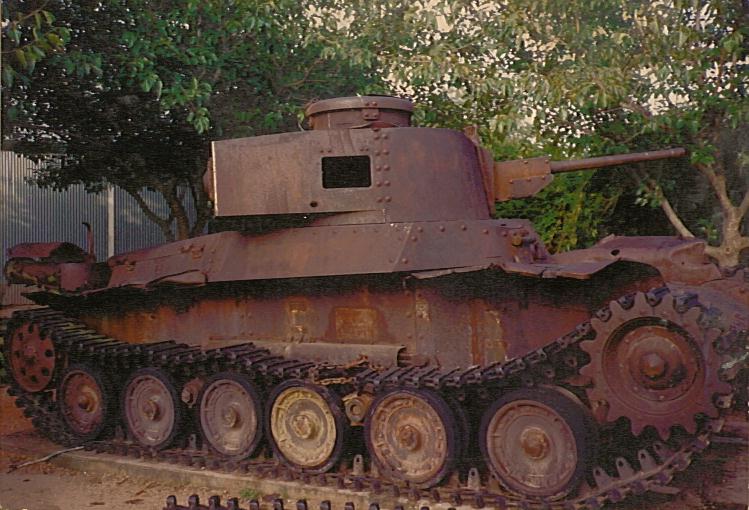
Type 97 Tank with Shinhoto Turret |
The Type 97 "Chi-Ha" was introduced in 1937 as the main tank in service with the Imperial Japanese Army. First seeing action in the China campaign, it was armed with a type 97 57mm short barrel main gun and two 7.7mm machine guns, with a third mounted on the top of the turret for AA use. The crew consisted of four men: a driver, radio/hull machine gunner, gunner, and tank commander who doubled as the loader.
In 1941, when the Imperial staff was planning their next moves against the United States, they realized that the low hitting power of the 57mm Infantry gun would not do against American tanks at the time, namely the M3 Stuart. So, the higher velocity Type 1 47mm anti-tank gun was adopted and put into a redesigned turret; the word "Shinhoto" means "New Turret."
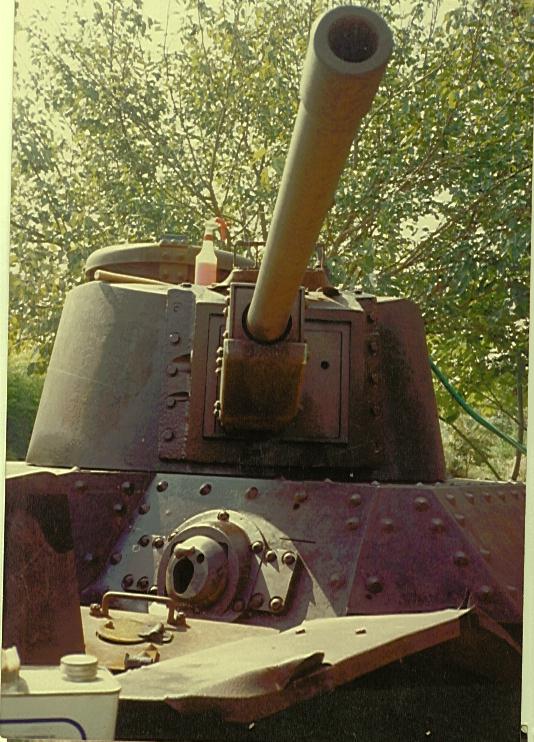
Type 1 47mm Anti-Tank Gun |
The Shinhoto had a basic layout, still retaining the four man crew; the driver sat on the forward right side, and the hull machine gunner on the left. The hull machine gunner had a close defense pistol port located just to his left, underneath the track, slightly forward of the front support roller. Neither man had a hatch of his own. Entry and exit of the vehicle was through the turret.
The turret was had a two man configuration: the gunner sat to the left of the gun with elevation done by means of a shoulder rest and no elevation wheel provided, and at his 11 o'clock position was a turret traverse wheel. Sighting of the gun was established by means of a single telescopic sight and firing of the gun was done by means of a solid brass pistol grip in the shape of the Nambu pistol located to the left of the breach. The gunner was provided a double split hatch on top of the turret.
The tank commander, who doubled as the loader, sat to the right of the gun, having a split hatch copula above his position, and a single monoscopic periscope sight housed in an armored dome just forward of the copula. Just to the commander's right and placed by his feet mounted on the right bulkhead of the chassis was a ready rack holding eight rounds for the 47mm gun. A main ammunition bin was located to the left rear of the vehicle holding a further 40 rounds. No turret basket was provided for the turret; the two men in the turret sat on folding seats mounted on the turret ring.
The entire fighting compartment of the hull and turret was insulated in asbestos sheets held in place by aluminum strips. A portion of the final drive and drive shaft from the engine was exposed in the fighting compartment with the drive shaft running forward to the transmission was located at the front. Only the drive shaft was covered by an aluminum shield.
The engine was a Mitsubishi eight cylinder diesel engine providing 170 hp at 2,000 rpm and located to the rear of the vehicle, producing a top speed of 38 km/h and had dual squirrel cage-style cooling fans located on either side of the engine. It is interesting to note that the fans were connected by means of drive shafts. Not one belt was ever used in or on the engine.
The entire vehicle was produced by Mitsubishi Heavy Industries, Ltd. and the rubber on the road wheels was provided by the Yokohama Rubber Company. A total production run of both types of "Chi-Ha" reached 2,208 vehicles during the war.
The above information came from first hand experience when, back in the mid '80s, I had the rare opportunity to begin the conservation efforts on one of the very few Shinhoto Chi-Ha's left in the world. The vehicle that I am talking about resides at the Nimitz Museum in Fredericksburg, TX, birthplace of Adm. Nimitz. I was approached by the director of the museum at the time because of my love of history, armor experience, and knowledge of World War II armor.
Now, this particular tank is locally known as the "mystery tank" for a couple of reasons. First, records show that before the Nimitz Museum, the vehicle came from San Clemente Island, CA firing range, which in turn came from Aberdeen Proving Grounds, MD, which in turn came from its initial shipping point of Ogden AFB, UT in 1946. Anything before that, there are simply no records anywhere to be found. Second, this Shinhoto has mounts for smoke dischargers mounted on the turret roof. The perplexing thing here is that there were only three Japanese tank regiments that had tanks equipped with smoke dischargers on the turret roof, those tanks being regular Type 97 Chi-Ha's, and those regiments were never issued with the Shinhotos. Now, you know why it is called the "Mystery Tank of Texas."
The following are excerpts from an article that I had written for a friend of mine who runs and maintains a website about the Imperial Japanese Forces of World War II.
After work, I loaded my car with reference books, clothes and several tool boxes and I headed out toward Fredericksburg. I awoke early that Saturday morning and inspected the Shinhoto Chi-Ha close up. On the exterior of the right side hull, two of the return rollers were broken off, the right track separated, several impact holes of various calibers all over the vehicle, left muffler completely missing, exterior completely rusted, turret rear access hatch and turret right side vision hatch completely missing. I then consulted the museum records to trace the origins of this vehicle and that itself became a puzzle.
My first task was to try to open the turret hatches as both were rusted shut. After six hours, I was able to open both hatches. I then climbed inside to survey the interior. Decay and rust had settled in, several items such as driver's levers, pedals and such had completely rusted off, a layer of compost dirt of about three inches deep had accumulated on the floor. Before any work was to be done inside, all dirt had to be removed. I constructed a sifter of a wood frame and fine mesh wire over an empty 55 gallon drum. All dirt was removed with a small shovel, brush and other small tools and then dumped into the sifter. Sifting the dirt took up the remainder of the day, but the rewards were just. In the dirt there was an aluminum engine data plate, a wood handle tooth brush broken in 3 places with Japanese writing, and several remnants of an Imperial Japanese Forces soft cap. All items were recorded, tagged, and stored in the museum's artifact room.
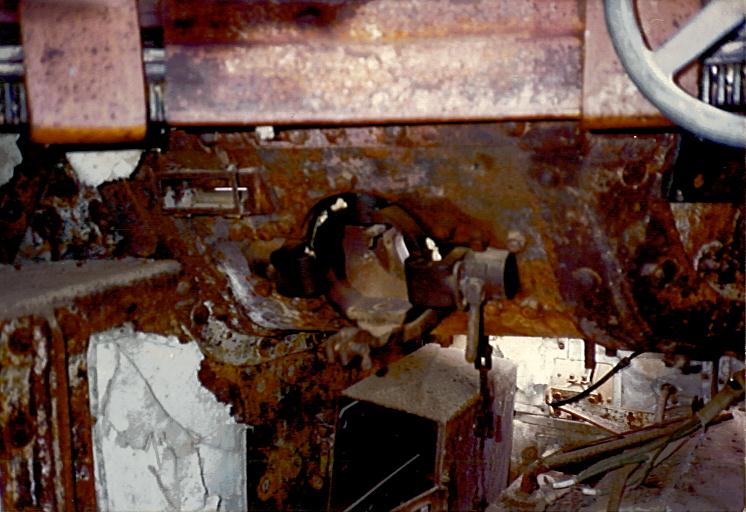
An asbestos panel located on the lower left |
Next came removing the most dangerous parts of the tank: the asbestos panels. Now, I do not know about the other tanks produced by Japan for the war, but the Shinhoto Chi-Ha was insulated in this manner. Average thicknesses of these panels were half an inch thick with an average size of two by three feet. Each panel was held in place by an aluminum strip framework similar to ceiling tiles, which was a good idea but a bad choice of materials. Having to wear a respirator, I spent that day removing these panels after making a detailed diagram showing size, shape and location. Due to age and being open to the elements, 75% of all panels I removed crumbled at the touch.
After removing the panels in the turret, I noticed some Japanese writing had been left intact. This writing appears to be a maker's mark or worker's proof mark. These were found just to the right of the gun mount. The primer color found inside of the vehicle appears as an orange/red and the writing in white.
The next three months of straight weekend work gave me insight into the design of Japanese vehicles. Even though this vehicle was badly damaged by time and weather on the inside, several things still worked such as the turret traverse wheels and gun breech. The Mitsubishi engine, in my opinion, was of a very good design as there were no belts of any kind found; everything ran off drive shafts including the 'squirrel cage' fans mounted on either side of the engine.
The major downfall of this vehicle that I could find was that the turret was not provided with any turret basket, whereby the commander and gunner had to walk with the turret as it traversed, having to step over the drive shaft and engine as part of it was exposed. Also, the driver and hull machine gunner had to pass through the turret to reach their positions as no hatches were provided for them.
The turret was found frozen in the 11 o'clock position. Turret is traversed by means of two hand crank wheels - one located at 11 o'clock for the gunner, the other at 3 o'clock for the commander who also acted as the loader. One revolution of the wheel would rotate the turret two and a half inches. There was also a flip latch located atop the gearing mechanism to secure the turret in traveling mode. The gunner was provided a shoulder rest to elevate or depress the gun; no mechanism was used. The triggering device was a simple pistol grip in the shape of the Nambu pistol made entirely out of brass. Sighting was done by means of a single telescopic sight.
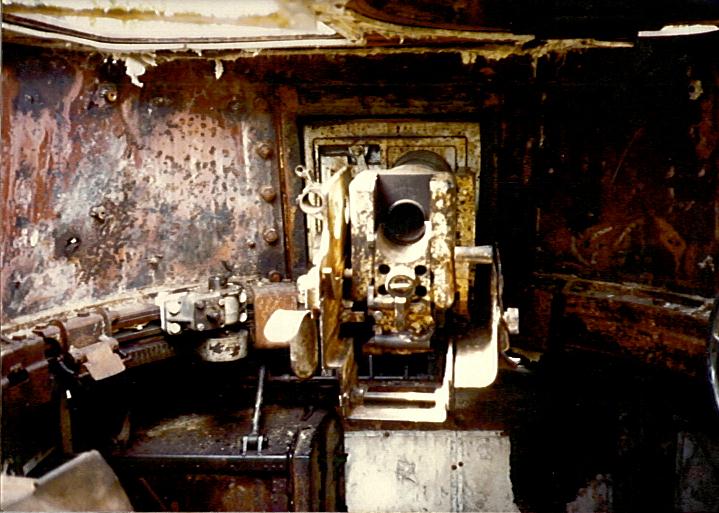
Inside the turret |
The driver sat in the forward right side of the hull; steering was done by means of the steering levers, and these were equipped with locking levers located at the gripping point. A parking brake was located just to the left of the driver, with accelerator and clutch pedals mounted on the floor. The vision port for the driver swings outward and is held in place via a locking arm prop. A rubber pad measuring approximately 4" x 8" x 1.5" thick is provided on the vision port for the driver’s forehead. The hull machine gunner sitting on the left side of the hull had one vision slit provided forward and a pistol port located just to his left on the lower hull, which viewed from the outside, was located behind the first return roller. It was covered by a 'tear-drop' shaped swing plate.

Atop the vehicle |
The two hatches located on the upper bow forward are not hatches for the crew. These are access to the transmission gears for maintenance. The main transmission was located between the driver and bow machine gunner. The main ammo bin holding 30 rounds for the 47mm gun was located on the lower left side hull which has a double door opening hinged in the middle and painted a light sky-blue. Another ammo rack holding 8 rounds was located on the right side lower hull, rounds pointed downward. A good portion of the engine was located inside of the fighting compartment exposed showing several fittings and drive shaft mounting, the drive shaft being covered by a thin aluminum shield. Wiring shows internal communication, but no evidence of a radio mount or wiring for such could be found on this vehicle. All vision ports were covered with one inch thick glass plates that were removable.
After four months of work, the director of the museum informed me that work to the Shinhoto Chi-Ha must come to a halt due to policy changes from park officials. I turned in all reports, findings, documents and such, loaded my tools into my car and as I stood in front of this vehicle with its barrel looming over my head, I had the immense pleasure knowing that I preserved a piece of history for future generations to see. Today when you see it, it is bursting out of a grove of bamboo, freshly painted with generic markings to represent all of the Japanese tank formations that served during World War II with pride.
 |
 |
 |
